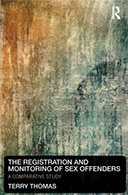The Registration and Monitoring of Sex Offenders:
A Comparative Study
 Author: Terry Thomas
Author: Terry Thomas
New York: Routledge, 2011. 188p.
Reviewer: Richard Tewksbury | May 2012
Concerns about the seeming proliferation of sex crimes have spurred dramatic changes in public policy responses and public perceptions of what sex offenses are, who commits them, and how communities can and should respond to such. In The Registration and Monitoring of Sex Offenders, Terry Thomas addresses these issues through discussions of the history of governmental registration systems, overviews of what registration and monitoring of sex offenders means, and how sex offender registration, community notification, and accompanying legal restrictions have been implemented in modern societies. Going beyond the standard approach of discussing and assessing such legal developments in only one jurisdiction, Thomas presents information from a wide range of nations, with primary emphasis on developments in the United States and United Kingdom.
Overall, this book discussed a range of important issues and introduces readers to these matters in a multitude of cultural contexts. For readers who know little more about sex offender registration and monitoring beyond what they see or read in their local news media, this book will be informative, instructive, and perhaps even persuasive. What is presented covers a broad range of issues, from detailed accounts of historical legal developments to political maneuverings leading to the establishment of contemporary laws to ways in which foundational, cultural values and beliefs have differentially shaped the focus and content of such laws. In general, the presentation is fair and seemingly unbiased, although when taken as a whole, the author clearly is arguing against the current forms and practices of registration in the United Kingdom and especially the United States.
Whereas the book presents discussion of a wide range of issues, this also is one of the weaknesses of the text. In a mere 159 pages of text, Thomas has tried to do too much, and unfortunately presents a book that lacks depth and at least in some instances, accuracy of information. All of this is regrettable for this reviewer to say, as the perspectives and conclusions of the book are ones with which I full-heartedly agree. However, while the destination to which this book leads the reader is one that is supported, the path of the journey and vehicles employed to reach this destination are simply flawed.
The book starts with historical overviews that in Chapter 2 focus on the background of creation and maintenance of written records used to establish and justify a range of governmental functions. Such “registers” and the process of documentation are traced as far back as the 16th century. Although clearly different in form and function, Thomas nonetheless argues that these basic processes of creating written documents and lists are the forbearers of registration processes in contemporary society. This argument is elaborated in Chapter 3, where Thomas looks at the development of more focused varieties of lists and registers for socially undesirable community members and criminals, focusing on the use of such in Germany (especially during the Third Reich), UK, and United States. Here are seen some of the dangers and important sources of resistance that citizens, and especially those populations targeted for documentation, offer against tyranny and intimidation by officials.
In Chapters 4 and 5, the focus moves to recent history with a concise yet informative set of summaries of the major legal developments in the last two decades in the United States and United Kingdom that created modern sex offender registration practices. Here the major state and national legislative developments are examined, with background and involved political processes highlighted.
In perhaps the most interesting of the discussions, Chapter 6 provides brief overviews, of varying depth and detail, of what sex offender registers are, how they are operated and how they came to be for 9 additional sovereign jurisdictions. While very interesting and instructive to see the many different ways that registration is done and the varying ways in which such are justified and limited in different governmental structures, it is a bit disappointing that this discussion is more or less just a straight-forward presentation of “facts.” Thomas has the opportunity here to provide readers with deep and valuable analyses of the how and why of differences, but instead elects to stop short of such efforts.
The range of cross-cultural discussions is expanded in Chapter 7 with very brief descriptions of efforts to develop and implement some form of a sex offender register in 6 additional nations. Also discussed are proposals for means of monitoring cross-border movements of registrants. While probably of minimal interest to American readers, this issue is of significance for residents of other nations, most notably those in Europe, where nations are geographically less sizable, and often have open borders.
Chapter 8 brings the discussion to that of community notification processes in the United States. In a very clear and strong manner, the meanings of community notification are explored, and the political processes and rationales for such practices utilized in the United States but largely not done elsewhere are explored. Included in this discussion is a brief overview of residency restrictions as official policies accompanying registration and community notification, with the focus once again on the United States.
Chapter 9, Making Sense of Sex Offender Registers, aims to be the analytic focus of the book, but is basically a mistitled chapter that really does not evaluate and assess information or registers and instead simply presents overviews of what goes into determining if a register is accurate, what some research says about how registered offenders experience their status, and in three pages addresses the major question of whether registers are effective or not. The treatment of each of these issues is cursory at best, and it is really not about “making sense” of such structures and practices. Additionally, the treatment of some of these issues is not very accurate. For instance, Thomas poses the question “What is the evidence that registration and community notification works?” and then follows with the statement that “one of the problems in this area is the lack of any research on these questions.” This is simply not true. In fact, there is a quickly and significantly growing body of research looking at exactly this point. It is surprising to not see any engagement with this body of literature, as the predominant findings here are that registration and community notification really do not show efficacy – this is a point Thomas would seem to likely embrace.
Finally, chapter 10 offers as a conclusion a discussion that actually is an introduction of theoretical issues that Thomas sees as applicable, although no real elaboration is offered beyond the oddly placed introduction of theoretical ideas. As these come in the very last pages of the book it is unclear how these theoretical perspectives are useful for understanding registers, community notification, the experiences of registrants or any other relevant issue.
Throughout the book, the extended discussions of developments in both the United States and United Kingdom provide important, although frequently only implicit, points of comparison that will lead the astute reader to question both the approaches that are used in each jurisdiction and push the readers to (re)consider their personal stances on these issues. The comparative aspect of the book is present, but primarily as a presentation of two models; only very rarely does Thomas offer any actual comparisons, or discussions of why differences are present between the two systems’ structures and processes.
The strengths of this book are in the fact that a broad range of issues are presented and actually discussed in easily understood and accessible ways, there are multiple (primarily two) models of sex offender registration and monitoring presented, and the reader will be drawn along in the presentation in ways that push them to reconsider their positions on issues and the reasons they hold those positions. On the negative side, the book lacks depth and evidence of quality scholarship. First, for a reader who is looking for a comprehensive summary and review of the existing social science literature regarding sex offender registration, monitoring and community notification, they are going to be very disappointed. When research is cited, there is a heavy reliance on individual sources, and a failure to acknowledge similar pieces, those with contradictory conclusions, or similarly focused studies using different samples or methodologies. Simply put, the depth of the literature drawn upon reflects that which would be expected in an undergraduate research paper. While the book presents a broad stroke in what is covered, the depth of the coverage is simply lacking. Additionally, there is no critique of the literature reviewed included, what is presented is accepted at face value, and accepted as “of course” accurate and applicable across contexts.
The quality of the scholarship that has produced this book must also be questioned. While this reviewer appreciated seeing some of his work included in the discussions of how to make sense of registers, the treatment of some of this work is not accurate. For instance, on page 148, when addressing the question of what is the evidence that registration and community notification works, Thomas provides a quote that seems to suggest that community members in general see registries as “highly inefficient and ineffective.” However, if one checks the provided citation, one sees that the quote is from a study of registered sex offenders. The research finding is presented out of context, and therefore misinterpreted. Additionally, this reviewer is further lead to question the accuracy of the citations, arguments, and “facts” provided throughout because at least some of the citations provided are just wrong. For instance, the citation to Levenson and Cotter (2009) used repeatedly to support the idea that family members of registered sex offenders suffer collateral consequences should be Levenson and Tewksbury. Consequently, if research findings are presented inaccurately and, if the citations are wrong, the critical reader must also ask what else might be wrong in the book. For this reader at least, that which I “learned” in other parts of the book must now be seen through a strong lens of skepticism.
The Registration and Monitoring of Sex Offenders is a book that promises to provide a comparative study of registration and monitoring across cultures. While information from multiple (but primarily just two) cultures is presented, it is merely presented and not assessed, examined or analyzed. At least some of the information in the book is incorrect, and the literature drawn upon may be a mile wide in the topics it covers, but has only about an inch of depth. This is a book that could be a valuable resource to scholars, policy makers, and the lay public interested in better understanding this very important and far-reaching topic, however, it falls short of being such a resource.
Richard Tewksbury. Professor of Justice Administration, University of Louisville


